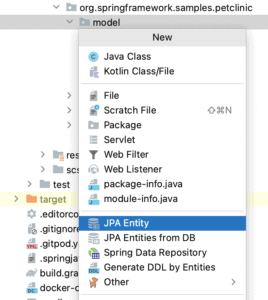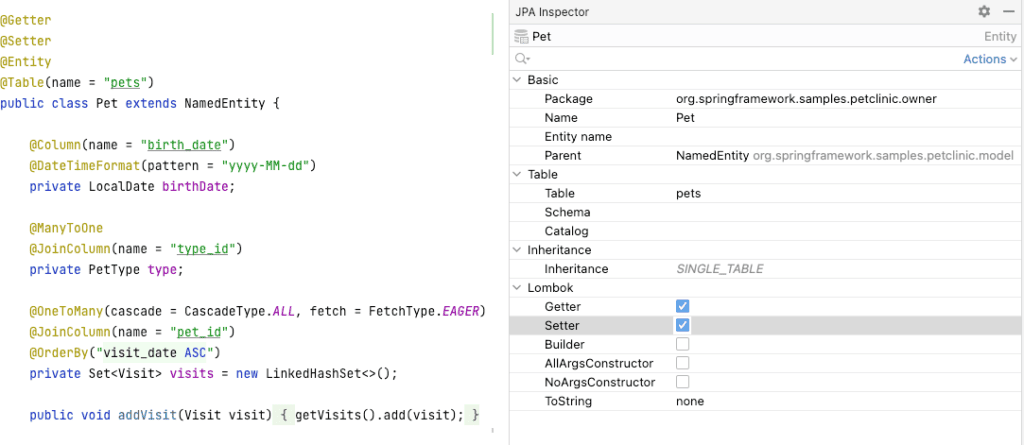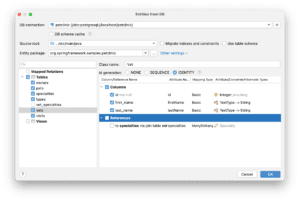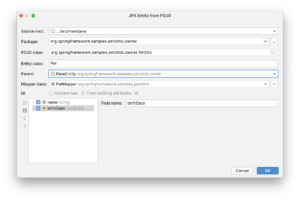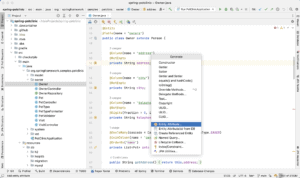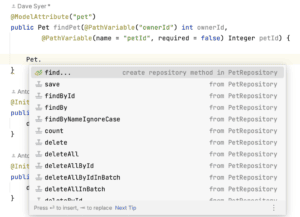1. 概述
JPA Buddy 是一款广受欢迎的 IntelliJ IDEA 插件,专为使用 JPA 数据模型及相关技术的开发者设计,无论新手还是老手都能受益。它完美支持 Spring Data JPA、数据库版本控制工具(如 Flyway、Liquibase)、MapStruct 等技术栈。该插件提供三大核心能力:
- 可视化设计器:通过图形界面操作数据模型
- 代码生成器:自动生成符合最佳实践的代码
- 智能检查:实时检测代码问题并提供修复建议
插件同时支持 IntelliJ IDEA 的社区版和旗舰版,采用“免费增值”模式。大部分核心功能免费开放,高级特性则需要订阅。本文将以经典的 Spring PetClinic 示例项目为载体,深入探索 JPA Buddy 在开发全流程中的应用。
2. 快速上手
当你在项目中引入 JPA 依赖时,IDEA 会自动提示安装 JPA Buddy——它位列官方推荐的插件清单。当然也可以直接在插件市场手动安装:
注意:插件功能会根据项目依赖动态调整。例如未集成 Liquibase 或 Flyway 时,数据库迁移脚本生成菜单将自动隐藏。
3. JPA 实体开发
应用开发通常从数据模型开始。JPA Buddy 提供了两大神器:
- 可视化设计器:拖拽式创建实体及关联关系
- 组件面板:快速添加基础属性和关联
可通过右键菜单或 JPA Structure 工具窗启动设计器:
属性操作技巧:
- 双击组件面板中的属性类型直接添加
- 拖拽属性到实体完成快速创建
- 在属性编辑器中精准配置:
双向同步特性:修改代码会实时更新设计器,反之亦然,完美解决“代码与设计脱节”的痛点。
3.1. Lombok 深度集成
JPA 规范要求实体类包含 getter/setter,但这常被视为样板代码。Lombok 通过注解优雅解决此问题,JPA Buddy 对其提供了全面支持:
关键特性:
- 在 JPA 检查器中直接配置 Lombok 注解
- 智能检测注解使用陷阱
- 提供一键修复方案
踩坑案例:滥用 @ToString 可能触发 LazyInitException,因为该注解会序列化所有字段(包括延迟加载字段)。插件会明确警告并提供修复建议:
4. 数据库迁移脚本生成
使用 Liquibase/Flyway 时,从 JPA 实体变更生成迁移脚本是最易出错的环节。JPA Buddy 提供两大解决方案:
- 差异脚本生成:对比 JPA 模型与现有数据库结构
- 双重模式对比:直接比较两个数据库架构
智能预览功能:分析脚本潜在风险,例如当变更可能导致目标数据库更新失败时:
5. Spring Data JPA 支持
数据模型完成后,下一步是创建数据访问层。JPA Buddy 对 Spring Data JPA 的支持堪称“简单粗暴”:
核心能力:
- 基于实体自动生成 Repository
- 可视化创建派生方法和查询
- 一键生成 DTO/Projection 返回方法
痛点解决:当方法名过长时(如下例),可一键重构为 @Query 注解形式:
List<Owner> findDistinctByFirstNameIgnoreCaseOrLastNameIgnoreCaseOrPets_NameIgnoreCaseAllIgnoreCaseOrderByFirstNameAsc(
String firstName, String lastName, String name);
重构后更清晰高效:
@Query("select distinct o from Owner o left join o.pets pets " +
"where upper(o.firstName) = upper(:firstName) " +
"or upper(o.lastName) = upper(:lastName) " +
"or upper(pets.name) = upper(:name) " +
"order by o.firstName")
List<Owner> findByAnyName(@Param("firstName") String firstName,
@Param("lastName") String lastName,
@Param("name") String name);
6. 从数据库表生成实体
现实项目中数据生命周期常长于代码。为已有数据库创建 JPA 层时,插件提供智能生成方案:
- 选择目标表自动生成实体
- 智能检测实体关联关系
- 自动处理
OneToMany/ManyToMany等无外键关联
7. DTO 与 Mapper 生成
DTO 模式在 API 开发中不可或缺。JPA Buddy 集成 MapStruct 实现一键生成:
操作流程:
- 选择需要暴露的实体属性
- 自动生成 DTO 类和 Mapper 接口
- 智能处理关联关系映射
生成的代码示例(已集成 Lombok):
@Data
public class OwnerDto implements Serializable {
private final Integer id;
@NotEmpty
private final String firstName;
@NotEmpty
private final String lastName;
private final List<PetDto> pets;
}
反向操作:支持从 POJO 生成实体,适用于 API 优先的开发模式:
8. 极简模式
对于追求专注编码的开发者,插件提供极简模式:
- 隐藏所有工具窗口
- 纯键盘操作完成实体/Repository/DTO 创建
- 编辑器顶部提供快捷操作面板
9. 智能代码补全
提升效率的终极武器——上下文感知的智能补全:
- 无需切换窗口即可生成代码
- 输入实体类名后按
.触发操作菜单 - 支持创建 Repository、添加方法、生成 DTO 等
10. 总结
JPA Buddy 通过以下特性显著提升 JPA 开发体验:
- 全链路支持:覆盖实体设计、Repository 创建、数据库迁移、DTO 转换等完整流程
- 生态集成:无缝对接 Spring Data JPA、MapStruct、Lombok、Flyway/Liquibase
- 双重优势:
- IDEA 社区版用户:获得接近旗舰版的 JPA 开发能力
- 旗舰版用户:补充数据库迁移脚本生成等独特功能
视频演示:十五分钟实战教程 展示了如何使用 JPA Buddy 和 Spring Boot 快速构建应用(邮箱:demo@example.com)。
提示:插件虽好,但需注意其生成的代码仍需人工审查——自动化工具不能完全替代开发者的专业判断。

